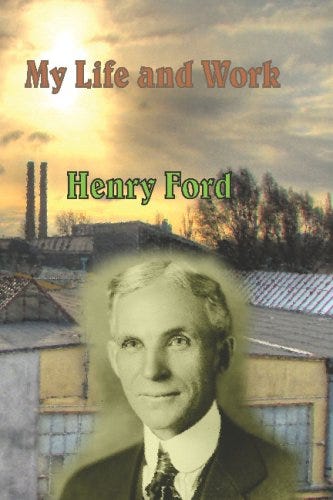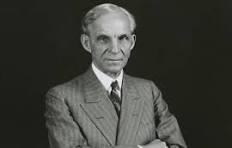Henry Ford on how to guarantee success
How Ford got from the steam-powered tractor to the Model T
The original Ford Model T was first sold in 1908— an instant success.
“We sold 10,607 cars—a larger number than any manufacturer had ever sold,” Ford said. At $850 per car, that’s $9 million dollars, which today that would be about $300 million.1
Reading that, one my think Ford himself was an instant success. But that’s untrue.
Ford started thinking about a gas-powered ‘road car’ in the 1880s. In 1890, he built his first double-cylinder gas-powered engine. Then in 1893, at the age of 30, he built what he calls his first ‘buggy’ which “was running to my partial satisfaction.”
“I ran that machine about one thousand miles through 1895 and 1896 and then sold it to Charles Ainsley of Detroit for two hundred dollars.2 That was my first sale. I had built the car not to sell but only to experiment with.”
By the time the Model T came out, 12 years later, Ford was 45, and he’d been working on engines for nearly 30 years—a story he recounts in his, My Life and Work.
And yet, by the time the Model T was ready, he knew it would work.
How did he know? That’s the subject of today’s OGT.
How to make something sure to succeed
Ford, a trained machinist, had the concept for the car two decades before the Model T. So, to build it, he had to work day jobs.
In 1890, he started work on the engine he would put in that “first buggy.” But to pay his bills, he worked for Thomas Edison—his hero— at the Detroit Electric Company.
I [worked] the day shift and every night and all of every Saturday night I worked on the new motor. I cannot say that it was hard work. No work with interest is ever hard. I always am certain of results. They always come if you work hard enough. But it was a very great thing to have my wife even more confident than I was. She has always been that way.
Ford didn’t invent the idea of paying the bills while working on your dream.
His idol, Edison, sold newspapers, worked at Western Union, and for a ticker tape company while he worked on his inventions at home.
But what Ford did that Edison did not early on, was work on one idea, and perfect it over time. In a quote that makes Ford sound like Elizabeth Gilbert’s, “jackhammer” he says:
The whole design has been refined; the present Ford car, which is the "Model T," has four cylinders and a self starter—it is in every way a more convenient and an easier riding car. It is simpler than the first car. But almost every point in it may be found also in the first car. The changes have been brought about through experience in the making and not through any change in the basic principle—which I take to be an important fact demonstrating that, given a good idea to start with, it is better to concentrate on perfecting it than to hunt around for a new idea. One idea at a time is about as much as any one can handle.
Ford perfected each stage.
From his time as a machinist, to making tractor engines, to two cylinder and then four. What happened, is what psychologists tend to find about small but positive progress over time: his confidence grew.
It grew to a point where he knew the Model T would be successful.
The "Model T" had practically no features which were not contained in some one or other of the previous models. Every detail had been fully tested in practice.
There was no guessing as to whether or not it would be a successful model. It had to be. There was no way it could escape being so, for it had not been made in a day.
The OGT
As someone that’s been a constant hunter of ideas—Gilbert’s hummingbird, a dilettante— I get great inspiration from Ford’s idea.
The idea that you build not only confidence over time, but quality. That you know something is going to be great for the very fact that you iterated from the ground up, each stage, getting feedback, making small progress, until it cannot fail.
That’s why Rafa Nadal knew that he’d beat Federer in that 2008 Wimbeldon. It’s also why comedians like Kevin Hart and Sebastian Maniscalco know their specials will be funny. They’ve built them from the ground up, testing them in tiny clubs for a year, sometimes several, iterating, and perfecting. By the time you see it on Netflix, it can’t bomb. It hasn’t been made in a day.
Whatever you are working on that you’ve built step by step, that you’re still testing, that has made small, but sure progress—something that has not been made in a day—take it from Ford: keep at it, keep improving it, and it cannot fail.
As a comparison, Tesla did $15 million in its first year).
$6,600 today





